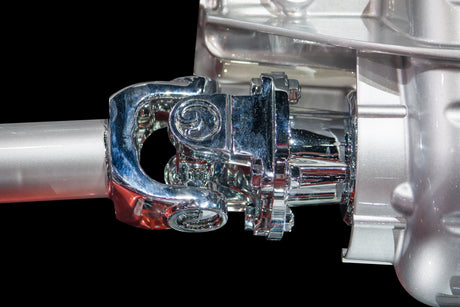The driveshaft is a critical component of your vehicle's drivetrain, responsible for transferring torque from the transmission to the differential and ultimately to the wheels. Despite its sturdy construction, the driveshaft can encounter several problems over time. Here, we’ll discuss the most common driveshaft issues and how to address them.
1. Vibrations and Shaking
Symptoms:
- Unusual vibrations or shaking from underneath the vehicle, especially at higher speeds.
- Often felt more strongly in the seats and floorboards.
Causes:
- Imbalanced driveshaft.
- Worn or damaged universal joints (U-joints).
Fix:
- Check for Imbalance: A professional can balance the driveshaft. This process involves adding weights to eliminate imbalances.
- Inspect and Replace U-Joints: Look for rust, wear, or looseness in the U-joints. Replace them if necessary, ensuring they are properly lubricated.
2. Clunking Noises
Symptoms:
- Clunking or banging noises when shifting gears or during acceleration/deceleration.
Causes:
- Worn or failing U-joints.
- Loose or damaged driveshaft components.
Fix:
- Inspect U-Joints: If the U-joints are the culprit, replace them immediately.
- Torque Bolts and Nuts: Ensure all bolts and nuts along the driveshaft are tight and secure as per the manufacturer's specifications.
3. Turning Issues
Symptoms:
- Difficulty turning or noticeable resistance when steering.
Causes:
- Binding or damaged constant velocity (CV) joints.
- Driveshaft angle issues.
Fix:
- Inspect CV Joints: Look for damage or excessive wear on the CV joints and replace them if needed.
- Check Driveshaft Angles: Especially in lifted vehicles, ensure that driveshaft angles are appropriately aligned. You might need adjustable control arms or new suspension components to correct the angles.
4. Leaks
Symptoms:
- Fluid leaking from the area around the driveshaft.
- Grease around the U-joints or CV joints.
Causes:
- Damaged seals.
- Worn slip yokes or splines.
Fix:
- Replace Seals: If seals are leaking, replace them promptly to prevent further damage.
- Inspect Slip Yokes and Splines: Check for wear and replace any damaged components to ensure proper lubrication and function.
Preventive Maintenance Tips
- Regular Inspection: Periodically check the driveshaft, U-joints, and CV joints for signs of wear and tear.
- Proper Lubrication: Keep U-joints and other moving parts well-lubricated according to the vehicle manufacturer’s recommendations.
- Balancing: If you notice vibrations, get the driveshaft balanced sooner rather than later to avoid additional wear.
By understanding these common driveshaft problems and knowing how to fix them, you can maintain the reliability and performance of your vehicle’s drivetrain. Regular maintenance and timely repairs not only enhance your driving experience but also prevent costly future damage.






